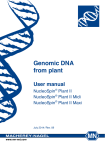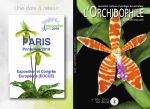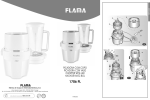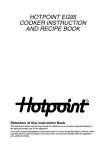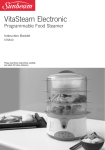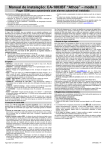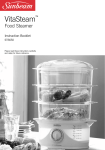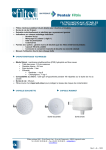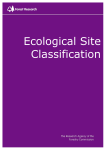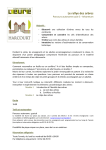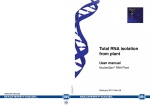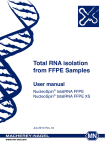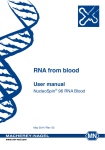Download Protocol
Transcript
Genomic DNA from PIant User manual NucleoSpin® Plant II www.mn-net.com MACHEREY-NAGEL October 2006/Rev. 01 MN MACHEREY-NAGEL EN ISO 9001: 2000 CERTIFIED MACHEREY-NAGEL MN Protocol-at-a-glance (Rev. 01) Genomic DNA Purification from Plant Mini ® NucleoSpin Plant II 1 Homogenize samples 2 Cell lysis 100 mg 400 µl PL1 PL1 10 µl RNase A 65°C, 10 min alternatively 300 µl PL2 10 µl RNase A 65°C, 10 min PL2 75 µl PL3 0°C, 5 min 2 min 11,000 x g 3 Filtration/ Clarification of lysate 4 Adjust DNA binding conditions 450 µl PC 5 Bind DNA 1 min 11,000 x g 6 Wash silica membrane (optional: 400 µl PW1 1 min 11,000 x g) 1 st 700 µl PW2 1 min 11,000 x g 2 nd 200 µl PW2 1 min 11,000 x g 7 Dry silica membrane 8 Elute highly pure DNA Drying is performed by the nd centrifugation during the 2 washing step 50 µl PE 70°C, 5 min 1 min 11,000 x g 50 µl PE 70°C, 5 min 1 min 11,000 x g MACHEREY-NAGEL GmbH & Co. KG • Neumann-Neander Str. 6-8 • D-52355 Düren • Germany Tel.: +49 (0) 24 21 969 270 • Fax: +49 (0) 24 21 969 279 • e-mail: [email protected] Genomic DNA from Plant Table of contents 1 Kit contents 4 2 Product description 5 2.1 The basic principle 5 2.2 About this user manual 5 2.3 Treatment of different plant samples 5 2.4 Kit specifications 7 2.5 Storage and homogenization of samples 8 2.6 Elution procedures 9 3 Storage conditions and preparation of working solutions 10 4 Safety instructions – risk and safety phrases 11 5 NucleoSpin® Plant II protocols 12 5.1 Standard protocol for genomic DNA from plant 12 5.2 Support protocol for genomic DNA from fungi 16 5.3 Support protocol for soil, compost, dung, and animal excrements 17 6 Appendix 18 6.1 Troubleshooting 18 6.2 Ordering information 20 6.3 Product use restriction / warranty 20 MACHEREY-NAGEL – 10/2006/ Rev 01 3 Genomic DNA from Plant 1 Kit contents NucleoSpin® Plant II 10 preps 50 preps 250 preps 740770.10 740770.50 740770.250 Buffer PL1 5 ml 25 ml 125 ml Buffer PL2 4 ml 20 ml 100 ml Buffer PL3 1 ml 5 ml 25 ml Buffer PC 6 ml 30 ml 125 ml Buffer PW1 6 ml 30 ml 125 ml Buffer PW2 (concentrate)* 6 ml 25 ml 50 ml Buffer PE 5 ml 15 ml 30 ml RNase A∗ 1.5 mg 6 mg 2 x 15 mg NucleoSpin® Filters (violet ring) 10 50 250 NucleoSpin® Plant II Columns (green ring) 10 50 250 NucleoSpin® Collecting Tubes (2 ml) 20 100 500 Protocol 1 1 1 Cat. No. ∗ For preparation of working solutions and storage conditions see section 3. 4 MACHEREY-NAGEL – 10/2006/ Rev 01 Genomic DNA from Plant 2 Product description 2.1 The basic principle After the plant samples have been homogenized, the DNA can be extracted with lysis buffers containing chaotropic salts, denaturing agents, and detergents. Lysis mixtures should be cleared by filtration using the NucleoSpin® Filters provided with the kits (alternatively by centrifugation) in order to remove polysaccharides, contaminations, and residual cellular debris. The clear flow-through is mixed with binding buffer PC to create conditions for optimal binding of DNA to the silica membrane. After loading this mixture onto the spin column, contaminants are washed away using different buffers in subsequent washing steps. The genomic DNA can finally be eluted with low salt elution buffer PE (5 mM Tris/HCl, pH 8.5) or nuclease-free water and is ready-to-use in subsequent reactions. 2.2 About this user manual Experienced users who are performing the isolation of genomic DNA from plant using a NucleoSpin® Plant II isolation kit may refer to the Protocol-at-a-glance instead of this user manual. The Protocol-at-a-glance is designed to be used only as a supplemental tool for quick referencing while performing the purification procedure. Firsttime users are strongly advised to read this user manual. 2.3 Treatment of different plant samples Plants are very heterogeneous and contain a lot of different metabolites like polyphenols, polysaccharides, or acidic components, which can lead to suboptimal extraction or subsequent processing of DNA. Therefore, we offer two different lysis buffers for the optimal processing, high yields, and a very good DNA quality with most common plant species. The standard protocol uses lysis buffer PL1, which is based on the established CTAB procedure. Additionally the SDS based buffer PL2 is provided with the kit which requires subsequent protein precipitation by potassium acetate (buffer PL3, provided). For some plant species buffers PL1 and PL2 can be used with similar results. However, for most plant material the lysis efficiency is different due to the negative charge of SDS and the positive charge of CTAB. In order to find optimal lysis conditions when using a certain plant sample for the first time, it is recommended to do side-by-side preparations of one batch of homogeneously ground material with both lysis buffers. MACHEREY-NAGEL – 10/2006/ Rev 01 5 Genomic DNA from Plant Table 1 gives an overview about customer data on different plant species that have been tested using NucleoSpin® Plant II. It indicates plant species that were successfully tested and the corresponding buffer system that was used. Important! For a large variety of plant species both lysis buffers will give good results. Use the table only for rough orientation and guideline which buffer system has already been tested. In order to obtain optimal results with your individual sample material we recommend to test both buffers in parallel to check which system will be suited best! Table 1: Plant species tested with NucleoSpin® Plant II Plant species Plant tissue/organ Lysis buffer successfully tested PL1 PL2 Abies alba (fir) needle 9 9 Amorphophallus titanum leaf 9 not tested Apium graveolens (celery) corm 9 9 Arabidopsis thaliana leaf 9 not tested Boreava orientalis 9 9 9 not tested Doritis pulcherrima leaf, herbarium sample inflorescence rachis, silica-gel dried leaf, silica-gel dried 9 not tested Eichornia azurea leaf 9 not tested Encephalartos natalensis leaf 9 not tested Galium aparine leaf 9 9 Hordeum spec. (barley) leaf 9 9 Isatis kotchyana leaf, herbarium sample 9 9 Laurus azorica (laurel) leaf 9 not tested Lupinus spec. (lupin) leaf 9 9 Lycopersicon esculentum (tomato) stem 9 9 Myagrum perfoliatum leaf, herbarium sample 9 9 Oryza sativa (rice) leaf 9 9 Persea feru./caerulea leaf 9 not tested Pteridium spec. leaf 9 not tested Pterocarya fraxiniofolia leaf 9 not tested Rosa spec. (rose) leaf 9 9 Rubus fruticosus (blackberry) leaf 9 9 Sameraria nummularia leaf, herbarium sample 9 9 Secale spec. (rye) leaf 9 9 Stereochilus sp. leaf, silica-gel dried 9 not tested Taucheria lasiocarpum leaf, herbarium sample 9 9 Trachycarpus takil leaf 9 not tested Trichoglottis sp. leaf, silica-gel dried 9 not tested Cleisostoma racemiferum 6 MACHEREY-NAGEL – 10/2006/ Rev 01 Genomic DNA from Plant Table 1: Plant species tested with NucleoSpin® Plant II Plant species Plant tissue/organ Lysis buffer successfully tested PL1 PL2 Triticum aestivum (wheat) leaf 9 9 Vigna radiata (mung bean) root 9 9 Zea mays (maize) leaf 9 9 Zea mays (maize) grain, dried, ground coarsley 9 9 fungal mycel (not specified) 9 not tested green algae (not specified) 9 not tested 2.4 Kit specifications • NucleoSpin® Plant II kits are designed for the isolation of genomic DNA from plant tissue and other biological samples like soil using two optimized lysis buffer systems based on the established CTAB and SDS methods. • NucleoSpin® Filters are included for conveniently clearing the lysate before loading it onto the NucleoSpin® Plant II columns. • RNase A is included to remove RNA and to allow photometric quantification of pure genomic DNA. • The optimized binding buffer PC and the optional chaotropic wash buffer PW1 completely remove proteins, RNA, metabolites, and other PCR inhibitors. • The eluted pure DNA is ready-to-use in subsequent reactions like PCR, restriction analysis, Southern blotting etc. Table 2: Kit specifications at-a-glance Parameters NucleoSpin® Plant II Sample size up to 100 mg wet weight up to 20 mg dry weight Typical yield 1-30 µg Elution volume 100 µl Binding capacity 50 µg Time/prep 30 min Column type mini MACHEREY-NAGEL – 10/2006/ Rev 01 7 Genomic DNA from Plant 2.5 Storage and homogenization of samples Plant samples can be stored in ethanol, lyophilized, or frozen. Fresh material can be kept at 4°C for one day but should be frozen at -20°C for longer storage. As plant tissue is very robust, the lysis procedure is most effective with wellhomogenized, powdered samples. Suitable methods include any type of commercial homogenizers (rotor-stator homogenizer) or bead mills using steel or glass beads. However, we recommend grinding with a mortar and pestle in the presence of liquid nitrogen to obtain optimal yields. After homogenization and treatment of the sample with lysis buffer, mixtures can be cleared easily either with a NucleoSpin® Filter (provided) or by centrifugation. Methods to homogenize samples 8 • Grinding with mortar and pestle in the presence of liquid nitrogen: Freeze plant material in liquid nitrogen and do not let the sample thaw at any time during homogenization. Pre-cool mortar and pestle using liquid nitrogen. Grind frozen sample thoroughly until a fine powder results and refill mortar occasionally with liquid nitrogen to keep the sample frozen. Use a pre-cooled spatula to transfer the sample in pre-cooled tubes. Make sure no liquid nitrogen is transferred or all nitrogen has evaporated before closing the tube. • VA steel beads (diameter: 7 mm, sample available on request): Put 4-5 beads and plant material into a 15 ml plastic tube (Falcon), chill the tube in liquid nitrogen and vortex for about 30 seconds (e.g. with a Multi Pulse Vortexer, Schütt Labortechnik GmbH, www.schuett-labortechnik.de). Repeat the chilling and vortexing procedure until the entire plant material is ground to a fine powder. Chill the tube once more and remove the beads by rolling them out gently or using a magnet. Keep the material frozen throughout the whole homogenization procedure. Do not add nitrogen to the tube since this leads to sticking and loss of plant material attached to the beads. • Rotor-stator homogenizers are only useful to disrupt soft plants in the presence of lysis buffer. Keep homogenizer submerged at all times to reduce foaming. MACHEREY-NAGEL – 10/2006/ Rev 01 Genomic DNA from Plant 2.6 Elution procedures The standard elution procedure is already optimized to yield 80-90% by eluting twofold at elevated temperatures. However, if even higher yields, high concentration, or maximum speed are required, the elution procedure can be adapted as follows: • Complete yield: 90-100% of the bound nucleic acids can be eluted by 1. performing two 100 µl elution steps (instead of two 50 µl steps) or 2. performing a third elution step with 50 µl (which means a total of three 50 µl elution steps). Keep the 5 minutes incubation at 70°C. • High concentration: 70-80% of the bound nucleic acids can be eluted highly concentrated by performing only one 50 µl elution step. Keep the 5 minutes incubation at 70°C. • Fast elution: 70-80% of the bound nucleic acids can be eluted by eluting only once with 100 µl elution buffer and cutting down the incubation time from 5 to 1 min. MACHEREY-NAGEL – 10/2006/ Rev 01 9 Genomic DNA from Plant 3 Storage conditions and preparation of working solutions Attention: Buffers PL1, PL2, PC and PW1 contain guanidine hydrochloride and/or detergents like CTAB or SDS! Wear gloves and goggles! • All kit components can be stored at room temperature (20-25°C) and are stable for up to one year. Before starting any NucleoSpin® Plant II protocol prepare the following: • Buffer PL2: Check for precipitated SDS especially after storage at temperatures below 20°C. If necessary incubate the bottle for several minutes at 30-40°C and mix well until the precipitate is redissolved completely. • Buffer PW2: Add the given volume of ethanol (96-100%) to buffer PW2 concentrate before first use. Store buffer PW2 at room temperature (20-25°C) for up to one year. • RNase A: Add the given volume of water (indicated on the vial, see below) to lyophilized RNase A. Store the RNase A solution at 4°C for up to 3 months. For longer storage (up to 1 year), the RNase A solution should be divided into small aliquots and stored at –20°C. NucleoSpin® Plant II Cat. No. Buffer PW2 (concentrate) RNase A 10 10 preps 50 preps 250 preps 740770.10 740770.50 740770.250 6 ml add 24 ml ethanol 1.5 mg dissolve in 150 µl H2O 25 ml 50 ml add 100 ml ethanol add 200 ml ethanol 6 mg dissolve in 600 µl H2O MACHEREY-NAGEL – 10/2006/ Rev 01 2 x 15 mg dissolve in 1500 µl H2O each Genomic DNA from Plant 4 Safety instructions – risk and safety phrases The following components of the NucleoSpin® Plant II kits contain hazardous contents. Wear gloves and goggles and follow the safety instructions given in this section. Component PC PW1 RNase A Hazard Contents Hazard Symbol guanidine hydrochloride + ethanol < 40 % Xn guanidine hydrochloride + isopropanol < 25% Xn RNase A, lyophilized ∗ ∗ Xn∗ Risk Safety Phrases Phrases Flammable. Harmful if swallowed. Irritating to eyes and skin R 10-2236/38 S 7-16 Flammable. Harmful if swallowed. Irritating to eyes and skin R 10-2236/38 S 7-16-25 May cause sensitization by inhalation and skin contact R 42/43 S 22-24 Risk Phrases R 10 R 22 R 36/38 R 42/43 Flammable Harmful if swallowed Irritating to eyes and skin May cause sensitization by inhalation and skin contact Safety Phrases S7 Keep container tightly closed S 16 Keep away from sources of ignition – No Smoking! S 22 Do not breathe dust S 24 Avoid contact with the skin S 25 Avoid contact with the eyes ∗ Label not necessary, if quantity below 125 g or ml (according to 67/548/EEC Art. 25, 1999/45/EC Art. 12 and German GefStoffV § 42 and TRGS 200 7.1) MACHEREY-NAGEL – 10/2006/ Rev 01 11 NucleoSpin® Plant II 5 NucleoSpin® Plant II protocols 5.1 Standard protocol for genomic DNA from plant Before starting with the preparation, set incubators or water baths to 65°C. Before elution, equilibrate elution buffer PE to 70°C. Note: The NucleoSpin® Plant II kits include two different lysis buffers for optimal results with most common plant species. Lysis buffer PL1 is based on the established CTAB procedure (positively charged detergent), buffer PL2 is based on SDS (negatively charged detergent). Please refer to section 2.3 for chosing the optimal lysis buffer system for your individual plant sample. 1 Homogenize sample Homogenize up to 100 mg wet weight or up to 20 mg dry weight (lyophilized) plant material (for homogenization methods see section 2.5). homogenize samples Proceed with cell lysis using buffer PL1 (step 2a) or alternatively buffer PL2 (step 2b). 2a) Cell lysis using buffer PL1 Transfer the resulting powder to a new tube and add 400 µl buffer PL1. Vortex the mixture thoroughly. + 400 µl PL1 If the lysis buffer volume is not large enough, the plant powder can be resuspended in additional buffer PL1. Note that the volume of binding buffer PC has to be increased proportionally in step 4. Add of 10 µl RNase A solution to the lysis mixture and mix sample. Incubate the suspension for 10 min at 65°C. For some plant material it might be advantageous to increase the incubation time to 30-60 min. Proceed with step 3. 12 MACHEREY-NAGEL – 10/2006/ Rev 01 + 10 µl RNase A 65°C, 10 min NucleoSpin® Plant II 2b) Cell lysis using buffer PL2 alternatively Transfer the resulting powder to a new tube and add 300 µl buffer PL2. Vortex the mixture thoroughly. + 300 µl PL2 If the lysis buffer volume is not large enough, the plant powder can be resuspended in additional buffer PL2. Note that the volumes of precipitation buffer PL3 (step 2b) and binding buffer PC (step 4) have to be increased proportionally. Add of 10 µl RNase A solution to the lysis mixture and mix sample. Incubate the suspension for 10 min at 65°C. + 10 µl RNase A 65°C, 10 min For some plant material it might be advantageous to increase the incubation time to 30-60 min. Add 75 µl buffer PL3, mix thoroughly and incubate for 5 minutes on ice to precipitate SDS completely. + 75 µl PL3 0°C, 5 min Proceed with step 3. 3 Filtration / Clarification of crude lysate Place a NucleoSpin® Filter column (violet ring) into a new NucleoSpin® collecting tube and load the lysate onto the column. Centrifuge for 2 min at 11,000 x g, collect the clear flow-through and discard the NucleoSpin® Filter column. If not all liquid has passed the filter, repeat the centrifugation step 2 min 11,000 x g If a pellet is visible in the flow-through, transfer the clear supernatant to a new 1.5 ml tube (not provided). Alternatively centrifuge the crude lysate for 5 min at 11,000 x g and transfer the supernatant to a new tube. 4 Adjust DNA binding conditions Add 450 µl binding buffer PC and mix by pipetting up and down thoroughly (5 times) or by vortexing. MACHEREY-NAGEL – 10/2006/ Rev 01 + 450 µl PC 13 NucleoSpin® Plant II 5 Bind DNA Place a NucleoSpin® Plant II column (green ring) into a new NucleoSpin® collecting tube and load the sample. Centrifuge for 1 min at 11,000 x g and discard the flowthrough. The maximum loading capacity of the NucleoSpin® Plant II column is 700 µl. For higher sample volumes repeat the loading step. 6 1 min 11,000 x g Wash silica membrane (optional) For some plant material, washing with chaotropic salts can further improve the purity by removing protein and other contaminants. Note: It can, however, lower the final yield by up to 15%. Add 400 µl wash buffer PW1 to the NucleoSpin® Plant II column. Centrifuge for 1 min at 11,000 x g and discard flow-through. 7 load sample (optional: + 400 µl PW1 1 min 11,000 x g) Wash and dry silica membrane 1st wash Add 700 µl buffer PW2 to the NucleoSpin® Plant II column. Centrifuge for 1 min at 11,000 x g and discard flow-through. + 700 µl PW2 1 min 11,000 x g Make sure ethanol was added to the PW2 concentrate. 2nd wash Add another 200 µl buffer PW2 to the NucleoSpin® Plant II column. Centrifuge for 2 min at 11,000 x g in order to remove wash buffer completely and dry the silica membrane. 14 MACHEREY-NAGEL – 10/2006/ Rev 01 + 200 µl PW2 2 min 11,000 x g NucleoSpin® Plant II 8 Elute highly pure DNA Place the NucleoSpin® Plant II column into a new 1.5 ml centrifuge tube (not provided). Pipette 50 µl buffer PE (heated to 70°C) onto the membrane. Incubate the NucleoSpin® Plant II column for 5 min at 70°C. Centrifuge for 1 min at 11,000 x g to elute the DNA. Repeat this step with another 50 µl of buffer PE (heated to 70°C) and elute into the same tube. MACHEREY-NAGEL – 10/2006/ Rev 01 + 50 µl PE 70°C, 5 min 1 min 11,000 x g + 50 µl PE 70°C, 5 min 1 min 11,000 x g 15 NucleoSpin® Plant II 5.2 Support protocol for genomic DNA from fungi 1 Homogenize sample Wash 50-200 mg mycelium (fresh weight) or material from a fruiting body of macro fungi in ethanol. Mycelium can be obtained from a liquid culture or scraped off (with or without agar) from the surface of a solid medium. Cover sample completely with ethanol and mix carefully. Short washing in ethanol is sufficient in most cases, although incubation overnight sometimes increases DNA yield. (Long-term storage in ethanol is also possible). Remove ethanol by pipetting and squeezing the mycelium. 2 Cell lysis Place the sample into a 1.5 ml reaction tube. Add 150 mg siliconized glass beads or sea sand and 200 µl buffer PL1. Homogenize sample using a micro pistil and vortex regularly. Add an additional 100 µl buffer PL1 and continue to homogenize the sample. If the lysis buffer volume is not large enough, more lysis buffer PL1 can be added. Note that binding buffer PC has to be increased proportionally in step 4. Optional: If a high RNA or protein content is present, we recommend to add 10 µl RNase A and/or proteinase K (5-10 mg/ml stock solution, see ordering information) to the PL1 lysis solution in order to minimize contaminants. Add 100 µl chloroform. Vortex for 10 s and separate phases by centrifugation for 5 min at 11,000 x g. Pipette the top aqueous layer into a new 1.5 ml centrifuge tube. The chloroform extraction step is optional but highly recommended. Incubate for 10 min at 65°C. For some fungi material it might be advantageous to increase the incubation time to 30-60 min. Proceed with section 5.1, step 3. 16 MACHEREY-NAGEL – 10/2006/ Rev 01 NucleoSpin® Plant II 5.3 Support protocol for soil, compost, dung, and animal excrements Note: This protocol requires an additional extraction buffer which is not provided in the kit: 2 M NaCl, 20 mM EDTA, 100 mM Tris-Cl, 2% (w/v) CTAB, 2% (w/v) Polyvinylpyrrolidon PVP, pH 8.0 1 Homogenize sample Weigh 5 g soil or 2 g dung into a petri dish. Add extraction buffer until the sample is completely soaked. Heat the sample in a microwave oven (400 W) for a few seconds until the extraction buffer is foaming. Extraction buffer may be added to keep the sample in a slushy state. 2 Cell lysis Transfer sample into a bead mill or mortar. Add 0.5 ml sea sand and disrupt the sample. 3 Filtration/Clarification of lysate Transfer the homogenized sample into a centrifuge tube (e.g. Sorvall SS34) and centrifuge for 10 min at 5,000 x g. Pipette 300 µl of the clear supernatant into a new 1.5 ml centrifuge tube. Proceed with section 5.1, step 3. MACHEREY-NAGEL – 10/2006/ Rev 01 17 Genomic DNA from Plant 6 Appendix 6.1 Troubleshooting Problem Possible cause and suggestions Homogenization of plant material was not sufficient • For most species we recommend grinding with steel beads or mortar and pestle (see section 2.5). For disruption of the cell wall it is important to homogenize the plant material thoroughly until the sample is ground to a fine powder. • Instead of freezing in liquid nitrogen the sample can also be lyophilized and easily ground at room temperature. Suboptimal lysis buffer was used • Lysis efficiencies of buffers PL1 (CTAB) and PL2 (SDS) are different and depend on the plant species. Try both buffers in a side-by-side purification to find the best detergent system to lyse your plant material. Suboptimal lysis buffer volume was used • DNA yield is low Cell lysis might be insufficient and too much DNA might get lost during lysate clarification if e.g. dry material soaks up too much lysis buffer. Use more lysis buffer and increase the volume of binding buffer PC proportionally. Suboptimal binding buffer volume was used • Increase binding buffer PC proportionally if more lysis buffer was used. Extraction of DNA from plant material during lysis was insufficient • Increase incubation time in lysis buffer (up to overnight). Suboptimal Elution 18 • The DNA can either be eluted in higher volumes or by repeating the elution step up to three times. Incubate NucleoSpin® Plant II column with elution buffer at 70°C for at least 5 minutes. • Also check the pH of the elution buffer, which should be in the range of pH 8.0 - 8.5. To ensure correct pH, use supplied elution buffer PE (5 mM Tris/HCl, pH 8.5). MACHEREY-NAGEL – 10/2006/ Rev 01 Genomic DNA from Plant Problem Possible cause and suggestions Sample was too viscous due to too much sample material or material carryover. NucleoSpin® Filter or NucleoSpin® Plant II column is clogged • Centrifuge large amounts of sample material before loading it onto the NucleoSpin® Filter. • Make sure cleared lysate is absolutely free of resuspended matter before loading it onto the NucleoSpin® Plant II column. • Increase centrifugation speed. • Use more lysis buffer PL1 or PL2. Sample was contaminated with DNase • DNA is degraded Preheat elution buffer to 70°C for 5 min to eliminate DNase contamination. This precaution is not necessary for buffers supplied by MACHEREY-NAGEL, which are delivered free of RNase and DNase. Centrifugation speed was too high • Centrifuge at a maximum speed of 11,000 x g. Higher velocities may lead to shearing of the DNA. Sample contains contaminants like phenolic compounds or secondary metabolites • Use optional washing step with wash buffer PW1 and repeat this step if necessary. Elution buffer contains EDTA DNA quality is low • EDTA may disturb subsequent reactions. Use water or the supplied elution buffer PE (5 mM Tris/HCl, pH 8.5) for elution. Salt or ethanol carryover • Make sure the last two wash steps were done with wash buffer PW2 according to the manual, and the membrane was dried at least for 2 min at ≥11,000 x g. MACHEREY-NAGEL – 10/2006/ Rev 01 19 Genomic DNA from Plant 6.2 Ordering information Product Cat. No. Pack of NucleoSpin® Plant II 740770.10 10 preps NucleoSpin® Plant II 740770.50 50 preps NucleoSpin® Plant II 740770.250 250 preps 740600 1000 740606 50 Buffer PL1 740927 125 ml Buffer Set PL2/PL3 740928 1 set Buffer PC 740937 125 ml Buffer PW1 740938 125 ml Buffer PW2 Concentrate 740939 50 ml RNase A 740505 100 mg RNase A 740505.50 50 mg NucleoSpin® collecting tubes (2 ml) NucleoSpin® Filter For filtration of cell homogenates 100 ml Buffer PL2 and 25 ml Buffer PL3 For 250 ml Buffer PW2 6.3 Product use restriction / warranty NucleoSpin® Plant II kits components were developed, designed and sold for research purposes only. They are suitable for in vitro uses only. No claim or representation is intended for its use to identify any specific organism or for clinical use (diagnostic, prognostic, therapeutic, or blood banking). It is rather the responsibility of the user to verify the use of the NucleoSpin® Plant II kits for a specific application range as the performance characteristic of this kit has not been verified to a specific organism. This MACHEREY-NAGEL product is shipped with documentation stating specifications and other technical information. MACHEREY-NAGEL warrants to meet the stated specifications. MACHEREY-NAGEL´s sole obligation and the customer´s sole remedy is limited to replacement of products free of charge in the event products fail to perform as warranted. Supplementary reference is made to the general 20 MACHEREY-NAGEL – 10/2006/ Rev 01 Genomic DNA from Plant business terms and conditions of MACHEREY-NAGEL, which are printed on the price list. Please contact us if you wish an extra copy. MACHEREY-NAGEL does not warrant against damages or defects arising in shipping and handling (transport insurance for customers excluded), or out of accident or improper or abnormal use of this product; against defects in products or components not manufactured by MACHEREY-NAGEL, or against damages resulting from such non-MACHEREY-NAGEL components or products. MACHEREY-NAGEL makes no other warranty of any kind whatsoever, and SPECIFICALLY DISCLAIMS AND EXCLUDES ALL OTHER WARRANTIES OF ANY KIND OR NATURE WHATSOEVER, DIRECTLY OR INDIRECTLY, EXPRESS OR IMPLIED, INCLUDING, WITHOUT LIMITATION, AS TO THE SUITABILITY, REPRODUCTIVITY, DURABILITY, FITNESS FOR A PARTICULAR PURPOSE OR USE, MERCHANTABILITY, CONDITION, OR ANY OTHER MATTER WITH RESPECT TO MACHEREY-NAGEL PRODUCTS. In no event shall MACHEREY-NAGEL be liable for claims for any other damages, whether direct, indirect, incidental, compensatory, foreseeable, consequential, or special (including but not limited to loss of use, revenue or profit), whether based upon warranty, contract, tort (including negligence) or strict liability arising in connection with the sale or the failure of MACHEREY-NAGEL products to perform in accordance with the stated specifications. This warranty is exclusive and MACHEREY-NAGEL makes no other warranty expressed or implied. The warranty provided herein and the data, specifications and descriptions of this MACHEREY-NAGEL product appearing in MACHEREY-NAGEL published catalogues and product literature are MACHEREY-NAGEL´s sole representations concerning the product and warranty. No other statements or representations, written or oral, by MACHEREY-NAGEL´s employees, agent or representatives, except written statements signed by a duly authorized officer of MACHEREY-NAGEL are authorized; they should not be relied upon by the customer and are not a part of the contract of sale or of this warranty. Product claims are subject to change. Therefore please contact our Technical Service Team for the most up-to-date information on MACHEREY-NAGEL products. You may also contact your local distributor for general scientific information. Applications mentioned in MACHEREY-NAGEL literature are provided for informational purposes only. MACHEREY-NAGEL does not warrant that all applications have been tested in MACHEREY-NAGEL laboratories using MACHEREY-NAGEL products. MACHEREY-NAGEL does not warrant the correctness of any of those applications. Please contact: MACHEREY-NAGEL Germany Tel.: +49 (0) 24 21 969 270 e-mail: [email protected] MACHEREY-NAGEL – 10/2006/ Rev 01 21






















